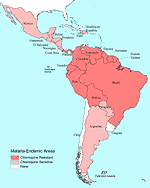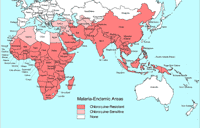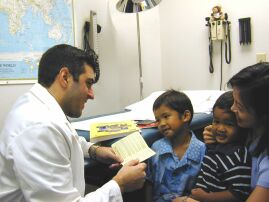|
|
|||||
|
|
Fall and Winter Travel SpotlightAre you planning to travel somewhere warm in the coming months? If you travel to the tropics or subtropics, you may be in an area where malaria is a problem. If so, you need to know how to protect yourself from this potentially deadly disease. On this Page:
This information is intended for travelers who reside in the United States. Travelers from other countries may find this information helpful; however, because malaria prevention recommendations and the availability of antimalarial drugs vary, travelers from other countries should consult health care providers in their respective countries. How To Protect Yourself
Persons who are traveling to malaria-risk areas can almost always prevent this potentially deadly disease if they correctly take an effective antimalarial drug and follow measures to prevent mosquito bites. CDC's Travelers' Health web site provides information on protecting the health of international travelers, including detailed country-specific malaria prevention information plus vaccination recommendations, food and water precautions, and safety information.
Despite these protective measures, travelers may become infected with malaria. Malaria symptoms can include fever and flu-like illness, including chills, headache, muscle aches, and fatigue. Malaria may also cause low blood cell counts (anemia) and yellowing of the skin and whites of the eye (jaundice). If not promptly treated, infection with Plasmodium falciparum, the most harmful malaria parasite, may cause coma, kidney failure, and death. Malaria is always a serious disease and may be a deadly illness. Travelers who become ill with a fever or flu-like illness either while traveling in a malaria-risk area or after returning home (for up to 1 year) should seek immediate medical attention and should tell the physician their travel history. Malaria-Risk AreasMalaria is transmitted in large areas of Central and South America, the island of Hispaniola (includes Haiti and the Dominican Republic), Africa, Asia (including the Indian subcontinent, Southeast Asia and the Middle East), Eastern Europe, and the South Pacific. Travelers to sub-Saharan Africa have the greatest risk of both acquiring malaria and dying from their infection. However, all travelers to countries with malaria risk may acquire this potentially deadly disease.
See CDC's Travelers' Health Travel Destinations for a map with links to malaria prevention information and other health recommendations. What Determines Your Individual Risk of Getting MalariaAll visitors to malaria-risk areas are at risk of acquiring malaria; however, many factors determine the risk to an individual traveler. Even in the same locale, these factors can vary widely over time. From year to year, conditions such as amount of rainfall, the number of mosquitoes, and the number of infected persons in the area will change and may produce a different level of risk than previously seen. Factors
that determine a traveler's risk of acquiring malaria include:
Special Note for Travelers from Countries Without MalariaTravelers from countries without malaria (such as the United States, Canada, the countries of Western Europe among others) are often at a high risk of becoming severely ill with malaria. Since malaria was eliminated from the United States in the late 1940s, most residents have never had malaria, have never developed resistance to the disease (immunity), and so are non-immune>. Malaria infection in a non-immune person can quickly result in a severe and life-threatening illness, sometimes in as few as 1-2 days after the start of symptoms. In addition, many U.S. travelers, their health-care providers, and tour companies may be unaware that their travel itinerary includes malaria-risk areas. Finally, health-care providers and laboratories in the United States rarely see cases of malaria and may be unfamiliar with the diagnosis and treatment of the disease, and this can delay effective treatment. Recent Immigrants to the U.S. from Malarious Countries Returning 'Home' to Visit Friends and Relatives
If
you now live in the United States and are planning a return visit home
to your country of origin, please consult the Recommendations
for Recent Immigrants from Malarious Countries Returning 'Home' to
Visit Friends and Relatives to
help protect the health of you and your family. Several factors increase the risk of malaria in this group:
Counterfeit (“fake”) DrugsIn some countries (including those with malaria risk), drugs may be sold that are counterfeit (“fake”) or substandard (not made according to United States standards). Such drugs may not be effective. Purchase your antimalarial drugs before traveling overseas!
Date: October 22, 2004 Content source: National Center for Infectious Diseases, Division of Parasitic Diseases
|
|
||||||||||||||||||||||||||||||
| Home | Policies and Regulations | Disclaimer | e-Government | FOIA | Contact Us | ||||||
|







